Oyster Perpetual

Yacht-Master
Staying on course, mapping invisible routes.
For those at sea, staying on course is a constant challenge. When dealing with the elements, nothing is certain and constant reaction is required to stay in the right direction. Since its launch in 1992, the Oyster Perpetual Yacht-Master has been equipped with a bidirectional rotatable bezel that facilitates the calculation and reading of navigational time. Elegantly combining functionality and nautical style, this watch has made its mark well beyond its professional realm.
A shared quest for precision
Knowing where you are in space and time, setting a course and sticking to it are vital in navigation. Given its function, the watch is an essential tool for sailors to assess their position. Regarded as the most precise horological instruments in the world, marine chronometers have been certified by astronomical observatories since the 18th century. At the time, the ultimate authority for measuring chronometric precision was the Kew Observatory in Great Britain.
In 1914, the founder of Rolex, Hans Wilsdorf, had one of the brand’s watches tested by this very observatory, which certified it as a chronometer: a first in the watchmaking world for a wristwatch. Since then, renowned sailors, such as Sir Francis Chichester and Bernard Moitessier, have navigated the seas with Rolex wristwatches serving as onboard chronometers.
Matching the precision of marine chronometers was fundamental to Rolex’s watchmaking.
Designed for navigators
Sailing occupies a special place in the world of Rolex. In 1958, the brand partnered the New York Yacht Club, creator of the legendary America’s Cup. Rolex then formed partnerships with several prestigious yacht clubs around the world and became associated with major nautical events – offshore races and coastal regattas.
These strong ties culminated in 1992 with the launch of the Yacht-Master. Boasting the robustness and waterproofness of our Oyster case, this chronometer is fitted with a bidirectional bezel with raised 60-minute graduations to enable navigational time to be calculated and read.
.css-1afbye{font-family:var(--quote-font-family);font-style:var(--quote-font-style);font-weight:var(--quote-font-weight);font-size:clamp(1.5rem, 0.6875rem + 2.0313vw, 3.125rem);line-height:1.3;}figure:not(.removem1epbs8d) .css-1afbye::before,figure:not(.removem1epbs8d) .css-1afbye::after{display:inline;}figure:not(.removem1epbs8d) .css-1afbye::before{content:var(--quote-opening);}figure:not(.removem1epbs8d) .css-1afbye::after{content:var(--quote-closing);}@media (max-width: 30rem){.css-1afbye{line-height:1.4;}}.short-quote .css-1afbye{font-family:var(--quote-font-family);font-style:var(--quote-font-style);font-weight:var(--quote-font-weight);font-size:clamp(1.875rem, 0.6250rem + 3.1250vw, 4.375rem);line-height:1.3;}figure:not(.removem1epbs8d) .short-quote .css-1afbye::before,figure:not(.removem1epbs8d) .short-quote .css-1afbye::after{display:inline;}figure:not(.removem1epbs8d) .short-quote .css-1afbye::before{content:var(--quote-opening);}figure:not(.removem1epbs8d) .short-quote .css-1afbye::after{content:var(--quote-closing);}@media (max-width: 30rem){.short-quote .css-1afbye{line-height:1.4;}} This Yacht-Master 42, which is an outstanding nautical watch, is also proof of Rolex’s firm commitment to yachting.
Precious on land and at sea
Available in three diameters – 37, 40 and 42 mm – and in various precious versions – 18 ct yellow, white and Everose gold – as well as in Everose Rolesor and Rolesium versions, the Yacht-Master is unique in the world of Rolex professional watches. An elegant watch with a sporty character, it was the first to be paired with an Oysterflex bracelet in 2015.
In 2023, after testing under real-life conditions by acclaimed helmsman Sir Ben Ainslie, Rolex launched a new version of the Yacht-Master 42. It is made of RLX titanium, a high-performance material, at once light, robust and corrosion resistant.
A veritable ally at sea, the Yacht-Master also elegantly adorns the wrists of navigators once back on solid ground. With many different versions, it is a model that transcends its seafaring origins. It has become a watch for those who know how to change course without losing sight of the horizon, moving freely.
Yacht-Master 42
Oyster, 42 mm, yellow gold.
Rolex Yacht-Master II Ultimate Buying Guide

In the exclusive world of luxury timepieces, the Rolex Yacht-Master II stands as an example of opulence and precision engineering. Since its unveiling in 2007, it has not simply followed the footsteps of its prized predecessor but has charted a new course in luxury timepieces. This masterpiece blends the functional demands of regatta timing with the uncompromising quality synonymous with the Rolex name. Its signature feature, a programmable countdown with on-the-fly synchronization, showcases Rolex’s commitment to innovation, tailored specifically for the strategic demands of yacht racing.

As we look into its history, features, and most sought-after models, this guide is designed for those who appreciate the finer things in life. Whether you’re looking to invest in a luxury timepiece or expand an existing collection, the Rolex Yacht-Master II represents a pinnacle of horological craftsmanship, a tangible asset that surpasses time and trends. Read on to learn all there is to know about the Rolex Yacht-Master II. <> <>
A Brief History of the Rolex Yacht-Master II
The Rolex Yacht-Master II , introduced in 2007, marked a significant evolution in Rolex’s line of luxury watches, diverging from the brand’s typically conservative design ethos. It was a striking departure from its predecessor, the Yacht-Master, representing a bold new direction in both aesthetics and functionality.

The original models of the Yacht-Master II were the 18k yellow gold ref 116688 and the even more luxurious 18k white gold version with a platinum bezel, ref 116689. These models showcased a large, eye-catching design that was an immediate topic of debate among watch enthusiasts. While some admired its noticeable presence, others viewed it as a deviation from Rolex’s traditional design roots.

Responding to the changing economic landscape following the 2008 financial crash, Rolex expanded the Yacht-Master II collection in 2011 with the introduction of the ref. 116681, a more affordable Everose Rolesor model. This model featured a stainless steel case and outer bracelet links combined with an Everose gold winding crown, pushers, and central bracelet links. The collection further broadened its appeal in 2013 with the introduction of the all-steel version, ref. 116680, which also debuted a new caliber, the Cal. 4161, replacing the former Cal. 4160.

The only notable design update since its launch occurred in 2017, on the watch’s tenth anniversary. This update included changes to the hour markers and hands, namely the blue hour marker surrounds replaced with white gold, the 12 o’clock marker changed to an inverted triangle, and a taller marker at 6 o’clock. These changes aligned the Yacht-Master II more closely with the rest of Rolex’s Professional Collection, yet the changes were subtle enough that Rolex did not assign a new reference number.
Throughout its history, the Rolex Yacht-Master II has been distinguished by its unique regatta timer function, a testament to Rolex’s commitment to innovative and functional design. This feature, along with its distinctive aesthetic, has made the Yacht-Master II a popular, though somewhat polarizing, model among collectors and luxury watch enthusiasts.

Key Features of the Rolex Yacht-Master II
The Rolex Yacht-Master II stands out from the Rolex catalog with its massive round case and striking dial design. Here are the distinguishing features of the Rolex Yacht-Master II. <>
The Oyster Case at 44mm
The Yacht-Master II’s Oyster case measures a notable 44mm in diameter, contributing to the watch’s bold aesthetic and enhancing the dial’s legibility. This large size is practical for a sports watch, ensuring that crucial timekeeping information is always easily readable. <>
Ring Command System
One of the Yacht-Master II’s innovative features is the Ring Command System. This system integrates the bezel, crown, and internal mechanism, providing a seamless way to set and synchronize the watch’s various functions, including its unique regatta timer.
The Rolex Yacht-Master II allows the wearer to choose a countdown interval, ranging from one to ten minutes, using its programmable flyback regatta timer, displayed on the middle of the dial. Additionally, the watch can be synchronized “on the fly” with audible cues that are commonly given at the start of regatta races. <>

Cerachrom Insert Bezel (for steel, Rolesor, and yellow gold models)
For the steel, steel and Everose, and yellow gold models, the bezel features a blue Cerachrom insert, made from an exceptionally hard and virtually scratchproof ceramic. This material is impervious to UV rays and corrosion, ensuring the bezel’s color and finish remain pristine over time. <>
Platinum Bezel in sandblasted finish (for white gold model)
Meanwhile, the 18k white gold model boasts of a platinum Ring Command Bezel, with a sandblasted background and polished graduations. <>
Chromalight Display
The Chromalight display on the Yacht-Master II offers superior legibility in all lighting conditions, especially in the dark. This innovative feature ensures that the watch face is easily readable, which is vital during demanding activities like sailing. <>

Perpetual Caliber 4160 / 4161
At the core of the Yacht-Master II is the Perpetual Caliber 4160, and for later models the 4161, a self-winding mechanical movement developed entirely by Rolex. Known for its precision and reliability, these movements showcase of Rolex’s expertise in watchmaking, featuring a programmable countdown with a mechanical memory, crucial for timing in regattas.
Models from 2007 to 2013 use the Caliber 4160. In 2013, with the introduction of the stainless steel model, the Caliber 4161 was given additional refinements such as a crisper feel to the pushers and greater reliability. Both movements possess the blue Parachrom hairspring that protects the movement from shocks and offer 72 hours of power reserve.
<> Models of the Rolex Yacht-Master II
There are four models available for the Rolex Yacht-Master II, three of which remain in production as of 2024. The white gold ref. 116689 was discontinued in 2022 but remains available in the pre-owned market.
| 116689 (disc.) | 18k white gold, platinum bezel |
| 116688 | 18k yellow gold, Cerachrom bezel |
| 116681 | Oystersteel & everose gold, Cerachrom bezel |
| 116680 | Oystersteel, Cerachrom bezel |

Rolex Yacht-Master II Stainless Steel Blue Bezel 116680
The Rolex Yacht-Master II Stainless Steel Blue Bezel 116680, introduced at Baselworld 2013, is a standout in the Yacht-Master II collection. This model features a large 44mm stainless steel case, showcasing Rolex’s expertise in crafting durable and stylish sports watches.

Its most striking feature is the blue Cerachrom bezel, a testament to Rolex’s innovation in materials, known for its scratch resistance and color permanence. The watch is equipped with the Rolex 4161 self-winding programmable flyback regatta timer movement, emphasizing its utility for sailing and regattas.
Its aesthetic is bold and extroverted, with a white dial, contrasting deep blue hands, and a red countdown hand, all contributing to its nautical theme. This model manages to balance Rolex’s high standards of functionality with a distinctive, eye-catching design. <> <>

Rolex Yacht-Master II Stainless Steel and Everose Gold 116681
The Rolex Yacht-Master II Stainless Steel and Everose Gold 116681, introduced in 2011, is a striking addition to the Yacht-Master II collection. It features a unique blend of robust 904L stainless steel and luxurious 18k Everose gold, embodying both resilience and elegance.

This model stands out with its vibrant blue Cerachrom bezel and a white dial – both enhanced with Everose gold elements. The watch is equipped with the advanced Rolex Cal. 4161 movement, offering specialized functionalities like a programmable countdown timer with mechanical memory and on-the-fly synchronization, tailored for yacht racing.
The combination of two-tone metals, along with its functional complexity and sizeable 44mm case, makes the Yacht-Master II 116681 a notable and luxurious sports watch. This model has garnered attention for its blend of technical prowess and bold aesthetic appeal. <> <>

Rolex Yacht-Master II Yellow Gold 116688
The Rolex Yacht-Master II Yellow Gold 116688, launched in 2007, is a landmark in Rolex’s esteemed collection. As the pioneering model of the Yacht-Master II series, this timepiece redefined the luxury sports watch segment.
It boasts a substantial 44mm case crafted from luxurious yellow gold, exuding both elegance and strength. The watch is notable for its blue Cerachrom bezel, a material celebrated for its exceptional scratch resistance and enduring color.

Inside, it initially housed the Rolex 4160 movement, renowned for its precise regatta timer function, pivotal for yacht racing enthusiasts. In 2013, Rolex introduced an upgrade to the 4161 movement, further enhancing the watch’s performance.
The Yacht-Master II 116688 blends luxurious gold craftsmanship with functional, sports-oriented features, establishing it as a prized and distinct offering in Rolex’s portfolio. This model’s combination of opulence and utility captures the essence of Rolex’s innovation in luxury sports watch design. <> <>

Rolex Yacht-Master II White Gold Platinum Bezel 116689
The Rolex Yacht-Master II reference 116689, introduced in 2007, is a distinctive model in Rolex’s lineup, combining 18k white gold with a platinum bezel. This watch stands out for its substantial 44mm case size, making it one of Rolex’s largest offerings.
Notably, the 116689 was part of the initial Yacht-Master II launch, which marked Rolex’s venture into more complex watch designs. This model features a regatta countdown timer, which was a significant technical achievement for Rolex.

The innovative Ring Command Bezel, directly linked to the watch’s internal movement, enables easy setting of the countdown timer. Inside, the watch initially used the Caliber 4160, which was updated to the Caliber 4161 in 2013.
The ref 116689’s unique combination of luxury materials, substantial size, and advanced functionality make it a noteworthy and potentially future classic Rolex model.
<> Final Thoughts
The Rolex Yacht-Master II series, with its unique blend of luxury, precision, and specialized functionality, offers a remarkable range of choices for collectors and enthusiasts. Whether it’s the bold statement of the Yellow Gold 116688, the innovative design of the Stainless Steel and Everose Gold 116681, or the understated elegance of the White Gold Platinum Bezel 116689, each model holds a special place in Rolex’s illustrious lineup. These watches are not only timekeeping instruments but also symbols of a luxurious lifestyle and a passion for the maritime world.
For those seeking to acquire or learn more about these exquisite timepieces, SwissWatchExpo presents an ideal destination. Their expertise and collection cater to a discerning clientele, making them a valuable resource for anyone looking to invest in a Rolex Yacht-Master II or expand their luxury watch collection.


advanced search

- Watches by brand
- Calibers by brand
- Yacht-Master
- 116688-0002 : Yacht-Master 2 Yellow Gold
Rolex - 116688-0002 Yacht-Master 2 Yellow Gold
| Brand: | |
|---|---|
| Family: | |
| Reference: | (aka: M116688-0002) |
| Name: | Yacht-Master 2 Yellow Gold |
| Movement: | |
| Produced: | 2017/4 - 2024 |
| Limited: | No |
| Material: | Yellow Gold |
|---|---|
| Glass: | Sapphire |
| Back: | Closed |
| Shape: | Round |
| Diameter: | 44.00 mm |
| Height: | 14.00 mm |
| Lug Width: | 21.00 mm |
| W/R: | 100.00 m |
| Color: | White |
|---|---|
| Indexes: | Stick / Dot |
| Hands: | Stick |
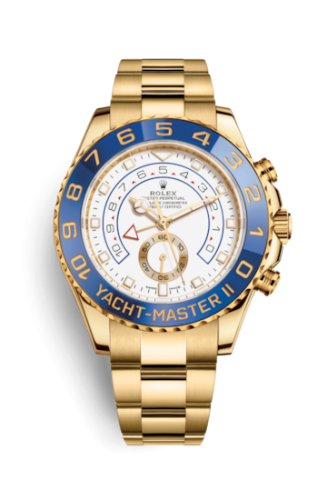
Price in euro
Rolex 116688-0002 description.
The Yacht-Master II is designed to meet the needs of professional sailors. This regatta chronograph features the world's first programmable countdown with a mechanical memory. It provides precise synchronization with the crucial starting sequence of a yacht race. The Yacht-Master II was first introduced in 2007 in white gold and yellow gold. In 2011 a version in stainless steel / Everose was added to the collection, while the stainless steel version was added to the collection in 2013 and in the same year the caliber 4160 movement was updated to the 4161. Reference 116688-0002 replaced the 116688-0001 in 2017.

© Copyright 2014-2024 - WatchBase.com - Terms of Use - Privacy Policy - About - Contact
E-Mail Us
Live Chat
305.865.0999
The Rolex Yacht-Master II, Four Ways

Perhaps one of Rolex’s most polarizing models to date, the Yacht-Master II is big, brash, and mechanically complex. There are those that love them and those that argue that the Yacht-Master II is the most un-Rolex of all Rolex watches. However, for those that do appreciate the modern size and design of the Rolex Yacht-Master II, there are plenty of versions to choose from. In fact, the Yacht-Master II is a Rolex collection that includes all the metals used by the brand–stainless steel, yellow gold, white gold, Everose gold, and platinum. Let’s have a look at the four versions of the Rolex Yacht-Master II.
Stainless Steel Rolex Yacht-Master II 116680

The most robust and affordable of the collection is, of course, the full stainless steel Yacht-Master II ref. 116680 . Sporting a 44 mm Oyster Case, the Yacht-Master II is one of Rolex’s largest watches (only the Deepsea is bigger thanks to its thickness) and it comes equipped with an Oyster bracelet.
Contrasting with the cool tones of the steel case and bracelet is the Yacht-Master II ref. 116680’s vibrant blue Cerachrom ceramic bezel, which matches the blue details on the information-packed dial. The Yacht-Master II offers a very niche complication targeted towards competitive sailors. Thanks to the Caliber 4161, the Yacht-Master flaunts a regatta chronograph complete with a mechanical memory (up to 10 mins).
Two-Tone Rolex Yacht-Master II 116681

If you’re a fan of two-tone Rolex sports watches, then there’s the stainless steel and gold Yacht-Master II ref. 116681. However, rather than using the more classic yellow gold, the Yacht-Master ref. 116681 pairs Everose gold with steel. Everose is Rolex’s patented rose gold alloy that the brand debut in 2005. Fashioned from a proprietary formula, Everose not only offers a beautiful luster but it promises to not fade over time.
On the Yacht-Master II ref. 116681, the Everose details are plentiful from the winding crown to the chronograph pushers to the center links on the Oyster bracelet to the bezel. The bezel insert is the same bright blue Cerachrom one, this time featuring Everose gold filled numerals. The dial also includes Everose gold touches, such as the Everose gold surrounds on the hour markers and the running seconds subdial.
Yellow Gold Rolex Yacht-Master II 116688

You’d be hardpressed to find a luxury watch company that makes a better solid gold watch than Rolex . And the yellow gold Yacht-Master II ref. 116688 is no exception. Built almost entirely in 18k yellow gold–except for that signature blue Cerachrom ceramic bezel–the Yacht-Master II 116688 is a status watch that commands attention wherever it goes.
In fact, due to its look, size, heft, and price tag, the yellow gold Yacht-Master II ref. 116688 is a favorite watch of celebrities and professional athletes. We’ve spotted actor Mark Wahlberg, MMA fighter Conor McGregor, rapper Drake, and other wearing the solid gold Rolex Yacht-Master II.
White Gold and Platinum Rolex Yacht-Master II 116689

For an ultra-luxurious take on the professional sailing watch, there’s the Yacht-Master II ref. 116689 which brings together two precious metals . The 44 mm Oyster case and hefty Oyster bracelet are crafted in 18k white gold while the bezel is made from platinum rather than ceramic.
Similar to the metal bezels of the Yacht-Master I watches, the Yacht-Master II ref. 116689’s platinum bezel includes glossy raised numerals sitting on a sandblasted background. These contrasting metal finishes capture the light in a fantastic way, and despite the monochromatic look of the Yacht-Master II ref. 116689, it simply gleams on the wrist.
The Evolution of the Rolex Yacht-Master II

The Yacht-Master II collection is one of the younger ones from Rolex, joining the company’s catalog in 2007. However, just last year in 2007 on the tenth anniversary of the watch, Rolex made some updates . Despite keeping the same reference numbers, the new versions of the Yacht-Master II include Mercedes-style hands instead of pencil style hands. Also new to the dial are the rectangular and triangular indexes at 6 and 12 o’clock, respectively. Everything else remains the same on the Yacht-Master II models.
Whether you opt for the steel, two-tone Everose gold and steel, yellow gold, or white gold and platinum Yacht-Master II, this is a Rolex watch that makes a statement–at sea on or land.
PREVIOUS ARTICLE
A Pair of Popular Audemars Piguet Royal Oak Offshore Watches Not To Miss
NEXT ARTICLE
Fall In Love With The Lady Arpels Pont des Amoureux Watch

RECOMMENDED ARTICLES

Exquisite Pre-owned Luxury Watches and Jewelry: New Arrivals for September 16, 2024
Read More About Exquisite Pre-owned Luxury Watches and Jewelry: New Arrivals for September 16, 2024

Luxury Watches and Jewelry: September 2024 New Arrivals and Pre-owned Gems
Read More About Luxury Watches and Jewelry: September 2024 New Arrivals and Pre-owned Gems

The Irresistible Attraction of Previously Owned Watches
Read More About The Irresistible Attraction of Previously Owned Watches

Exquisite Pre-owned Watches and Jewelry: New Arrivals for September 14, 2024
Read More About Exquisite Pre-owned Watches and Jewelry: New Arrivals for September 14, 2024

Exciting New Arrivals and Pre-owned Luxury Watches at Gray and Sons: September 13, 2024
Read More About Exciting New Arrivals and Pre-owned Luxury Watches at Gray and Sons: September 13, 2024

Exquisite Pre-owned Luxury Watches and Jewelry: New Arrivals for September 12, 2024
Read More About Exquisite Pre-owned Luxury Watches and Jewelry: New Arrivals for September 12, 2024

The Most Iconic Luxury Watch Brands and Their Best Models Revealed
Read More About The Most Iconic Luxury Watch Brands and Their Best Models Revealed
The Rolex GMT-Master II Steel & Yellow Gold 126713GRNR, And Why I Fell For It
I shouldn't like this watch... but i actually do..
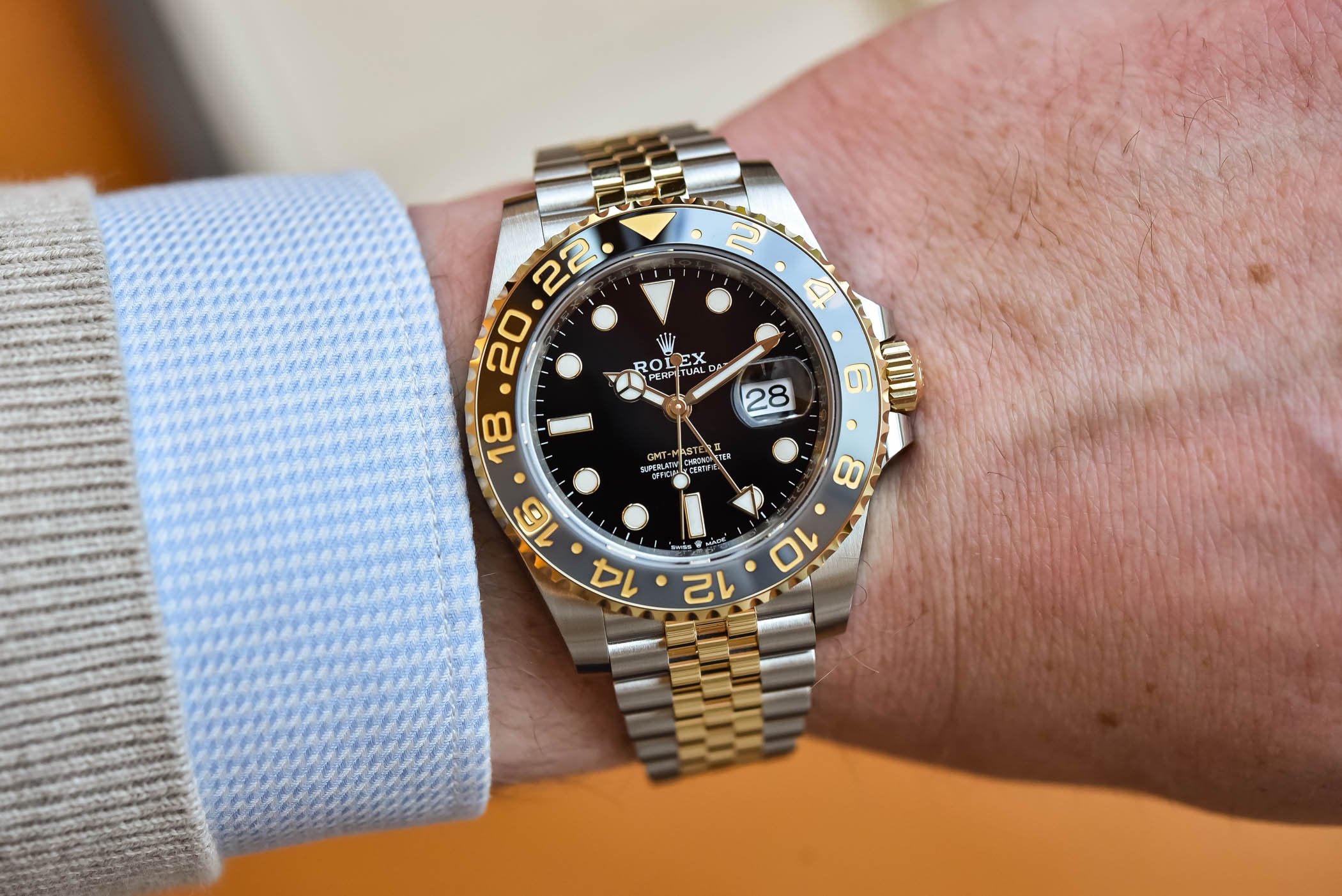
Of course, there were some more important new models presented by Rolex at Watches and Wonders 2023. The updated Daytona , moving to a 12xxxx generation, the titanium Yacht-Master 42 or a new dress watch, the convincing Perpetual 1908 . Nevertheless, a pair of new models – to make it clear, colour and material updates on an existing watch – managed to get quite some traction. I’m talking about new yellow gold-equipped GMT-Master II watches , and specifically the Steel and Yellow Gold (call it two-tone or yellow Rolesor) reference 126713GRNR. At first, this watch should be everything I don’t like… But life is sometimes surprising.

Above: the 116713LN and 116718LN, models discontinued circa 2019, equipped with yellow gold case/bracelet, or yellow Rolesor case/bracelet – images by www.watchclub.com
Before I go up close and personal with the 126713GRNR (reference numbers are going more and more complex at Rolex…) we first need to recap the facts, and look at this new two-tone steel and yellow gold GMT-Master II for what it is. First of all, next to the full yellow gold version (reference 126718GRNR), this new model marks the return of yellow gold in the collection. Indeed, since the discontinuation of the solid yellow gold models – 116718LN green or black dial – and the two-tone yellow Rolesor – 116713LN – a few years ago, your only option for precious metal GMTs were Everose (solid or matched with steel ), or white gold . And, also important, they all come on an Oyster bracelet.
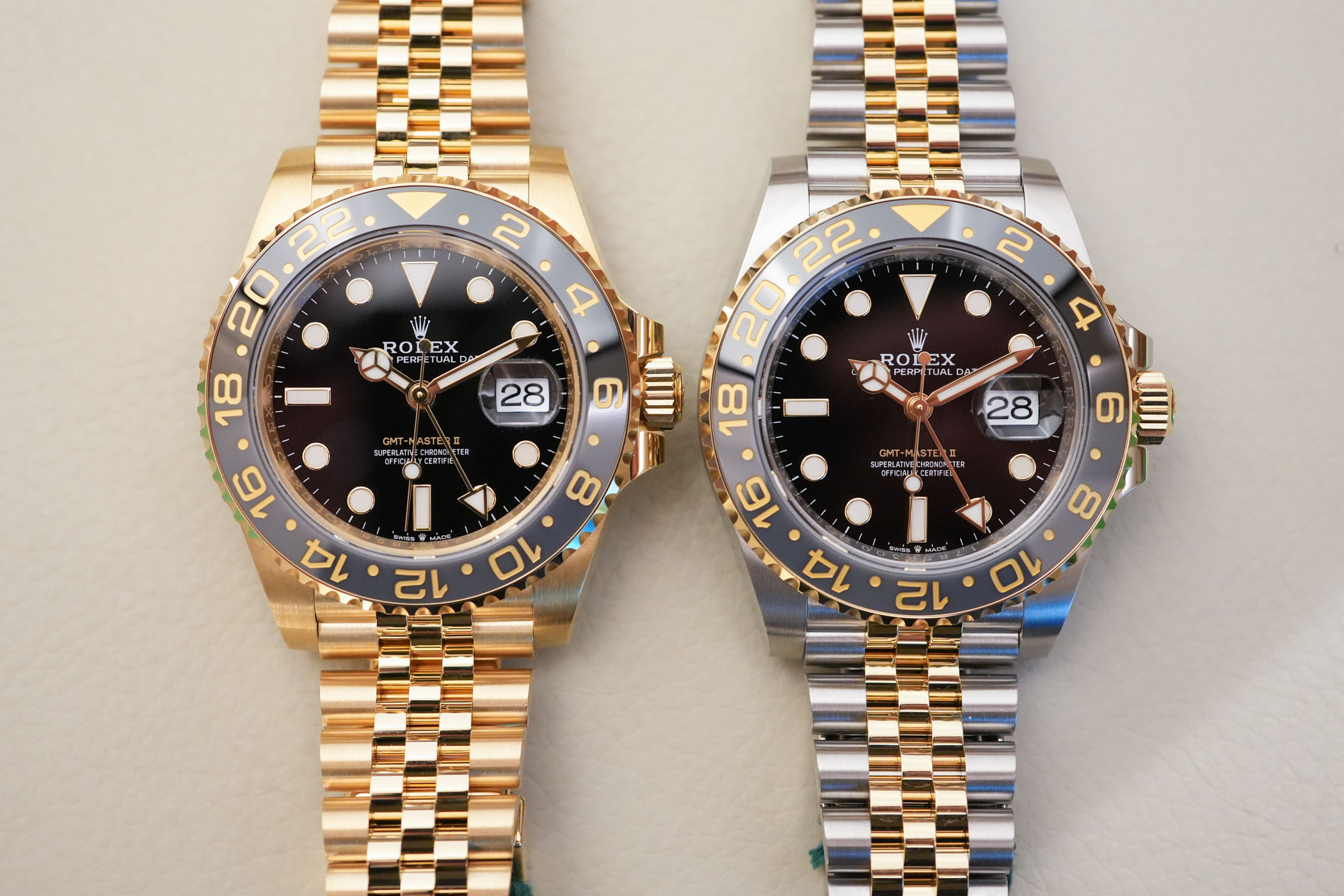
These two new models feel actually very much like no-brainers, like unsurprising, totally expected models. Why? Because it feels natural to have Yellow Rolesor or solid yellow gold models in the collection. The watches you assume exist… but actually didn’t, at least for some years (from 2019 to 2023). So what’s the deal in 2023? Well, first of all, yellow gold, as a stand-alone material or combined with steel, returns to the Rolex GMT collection. Second, there’s a new two-tone bezel, in an unprecedented colour combination. Third, there’s a Jubilee bracelet in precious metal on the GMT, which is not only new but also hot. Last, I hate to say it, but they look very attractive. And I believe that it’s quite a general consensus here.
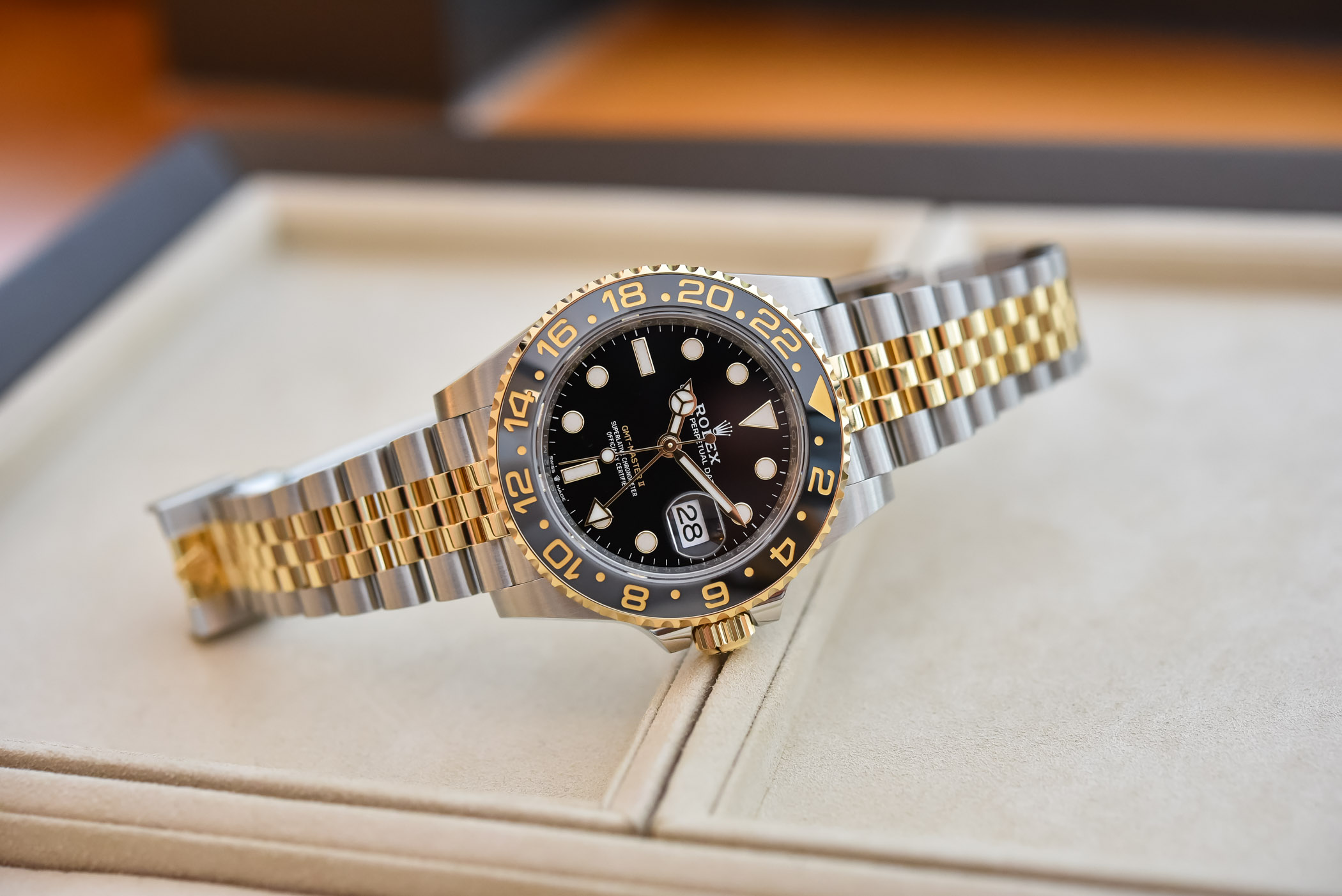
Today, I’ve decided to specifically look at the GMT-Master II Steel and Yellow Gold 126713GRNR. Why? First of all, while being a highly attractive watch, the full gold model is very flashy indeed and retails for almost 40k euros. Not very “wide audience” watch material. Second, the two-tone version has made yet another impression on me. It’s rather interesting to look at how tastes and trends evolve. Two-tone watches used to have a rather negative image in the past, but they’ve moved from “poor man’s” options (understand, I want gold but can’t afford the solid gold one) to “cool man’s” options recently. So, here’s my choice. Even I have a hard time explaining why… It’s everything I shouldn’t like.
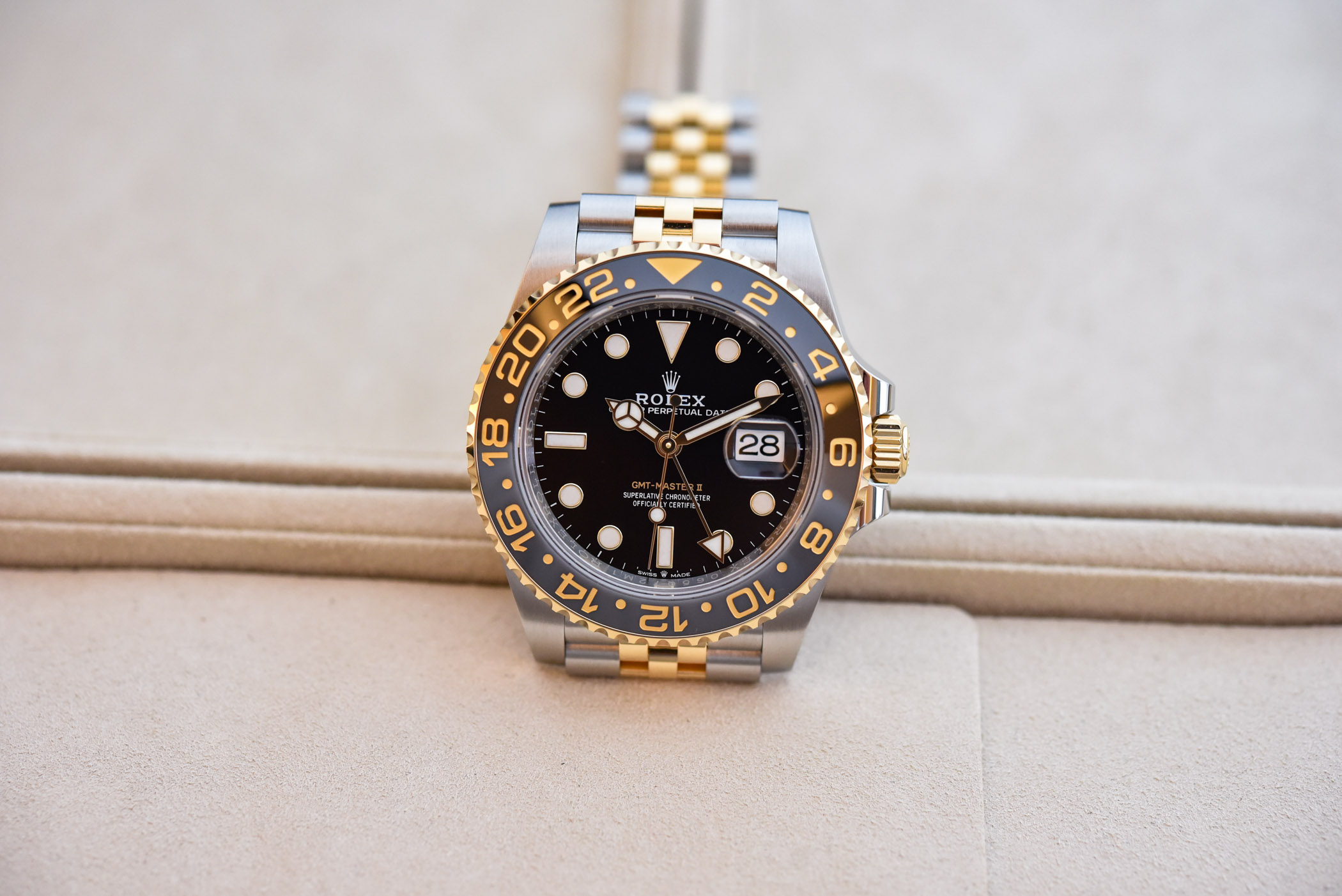
Back to basics. This new Steel and Yellow Gold Rolex GMT is nothing more than a visual update. Case; the same Oystersteel middle case as before, measuring a typical Rolex 40mm diameter, a relatively thin 11.90mm height (it’s still a sports watch with a rotating bezel and 100m water-resistance after all), and a still acceptable 48mm length. Dimensions, shapes, and finishes are all identical to a Pepsi or a Batgirl , with now a solid 18k yellow gold Triplock screw-down crown and notched bezel. The other novelty comes from the new ceramic insert, in an unprecedented combination of black and mid-grey ( GR is N oi R ). And I must that this muted, discreet combination pairs brilliantly with the warm tone of YG. As if Rolex wanted to keep the attention only on the gold accents, whether on the case, bracelet, bezel or dial. The rest is all discreet, subtle. This new insert is almost like a graduation on black. And I think it works even better next to the steel parts of this Rolesor edition.
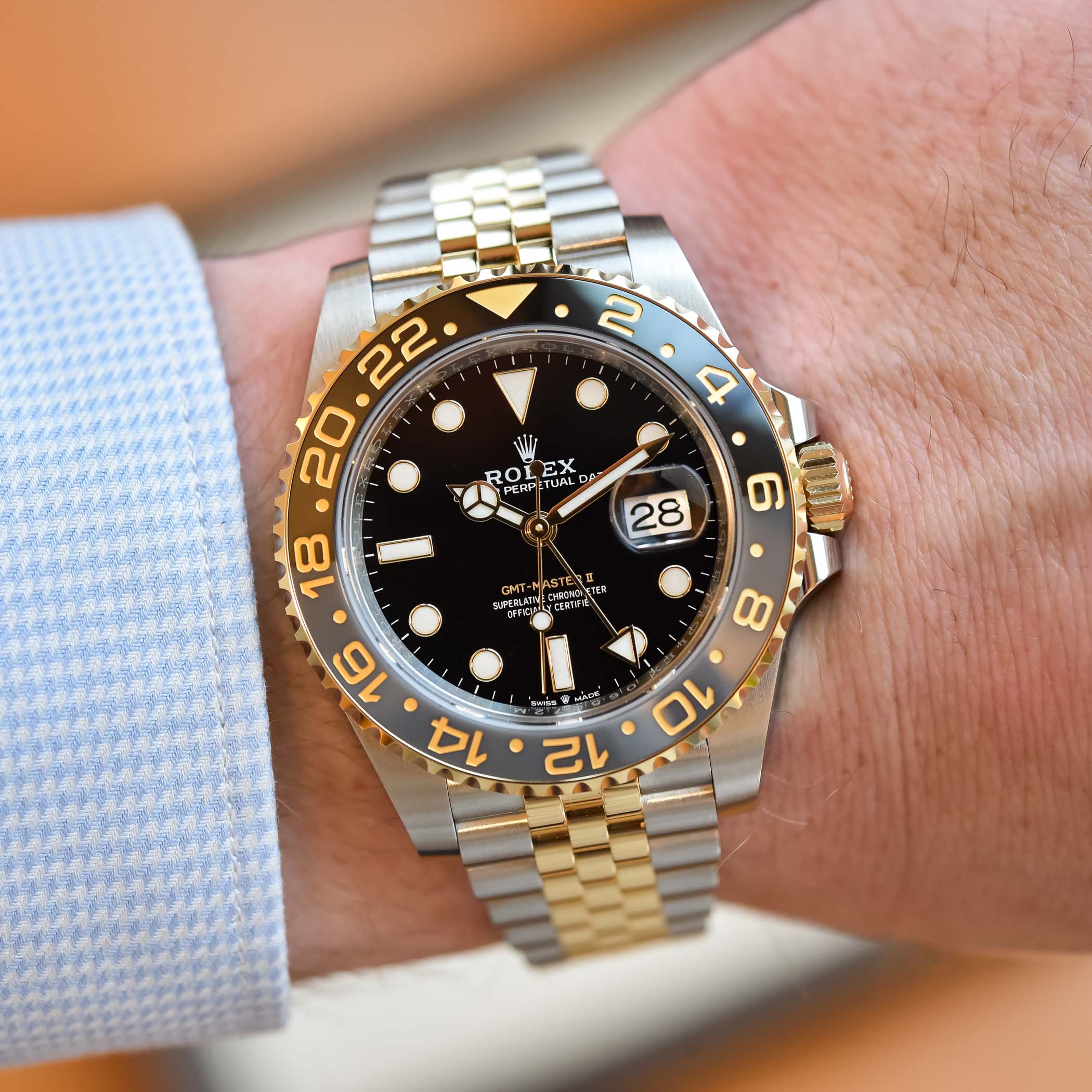
As for the dial, it’s pretty straightforward too. No evolution to be noted in the design, it’s all about the colours and materials. As you’d expect, the black lacquered base is glossy, with applied hour markers and hands that match the case – thus, made of 18k yellow gold. And Rolex has also been slightly restrained when it comes to touches of colour. No flashy green or red accents on the GMT hand and GMT-Master II mention, just the same tone of gold as the rest of the dial. Tasteful and elegant, with just the dosage of bling you want in a gold or two-tone watch.
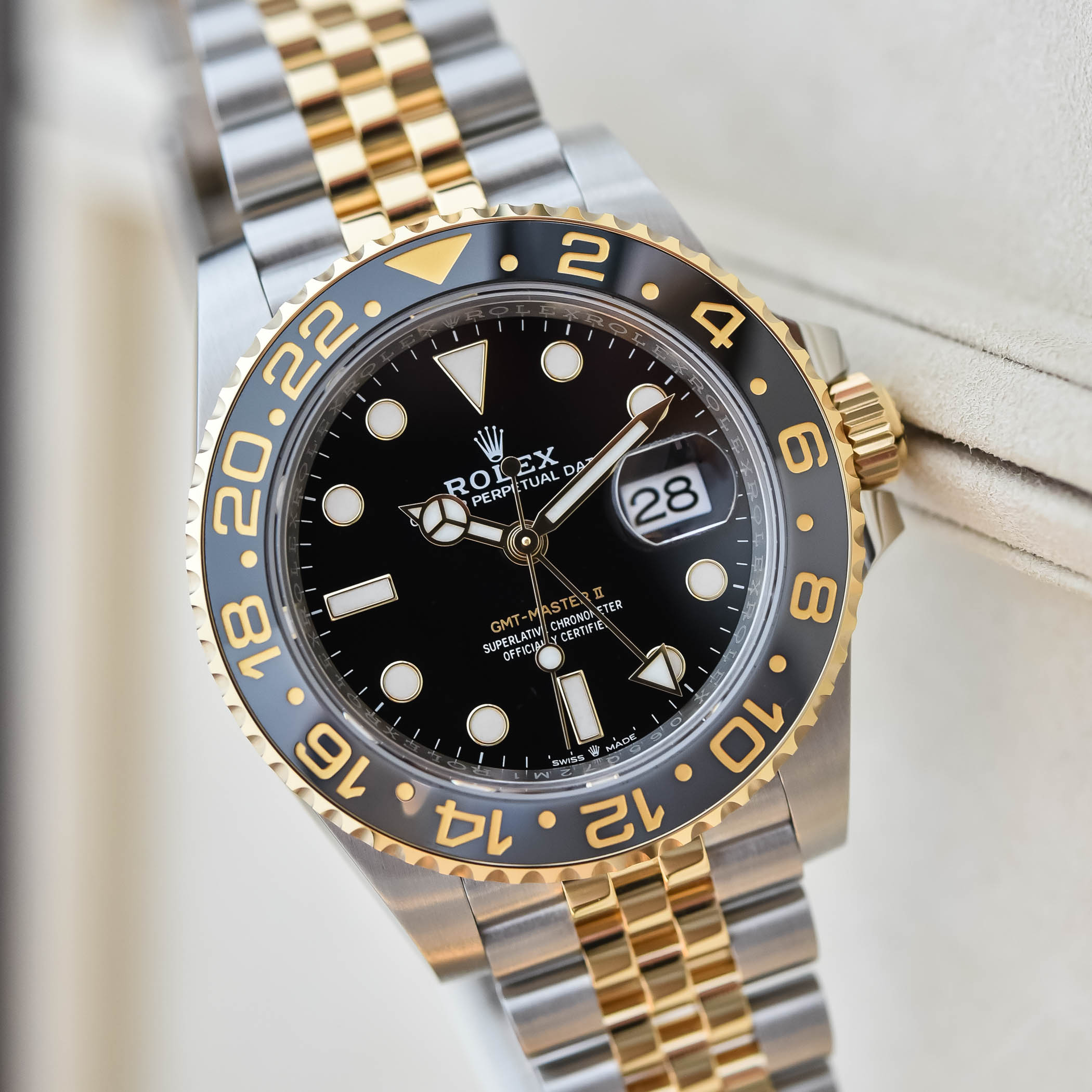
Importantly, this new GMT-Master II two-tone 126713GRNR, as well as the full yellow gold model, marks the first appearance of the Jubilee bracelet on precious metal GMT watches. It was only reserved for the steel Pepsi , Batgirl and Destro versions up until now. It means a 5-link, slightly vintage bracelet with polished 18k gold central links and brushed steel external links. Clasp; classic Oysterlock folding safety clasp with Easylink comfort extension link. Comfort; classic Jubilee, supple, soft and flexible. And the look is just as good as it gets (if you love Rolex and this style, of course).
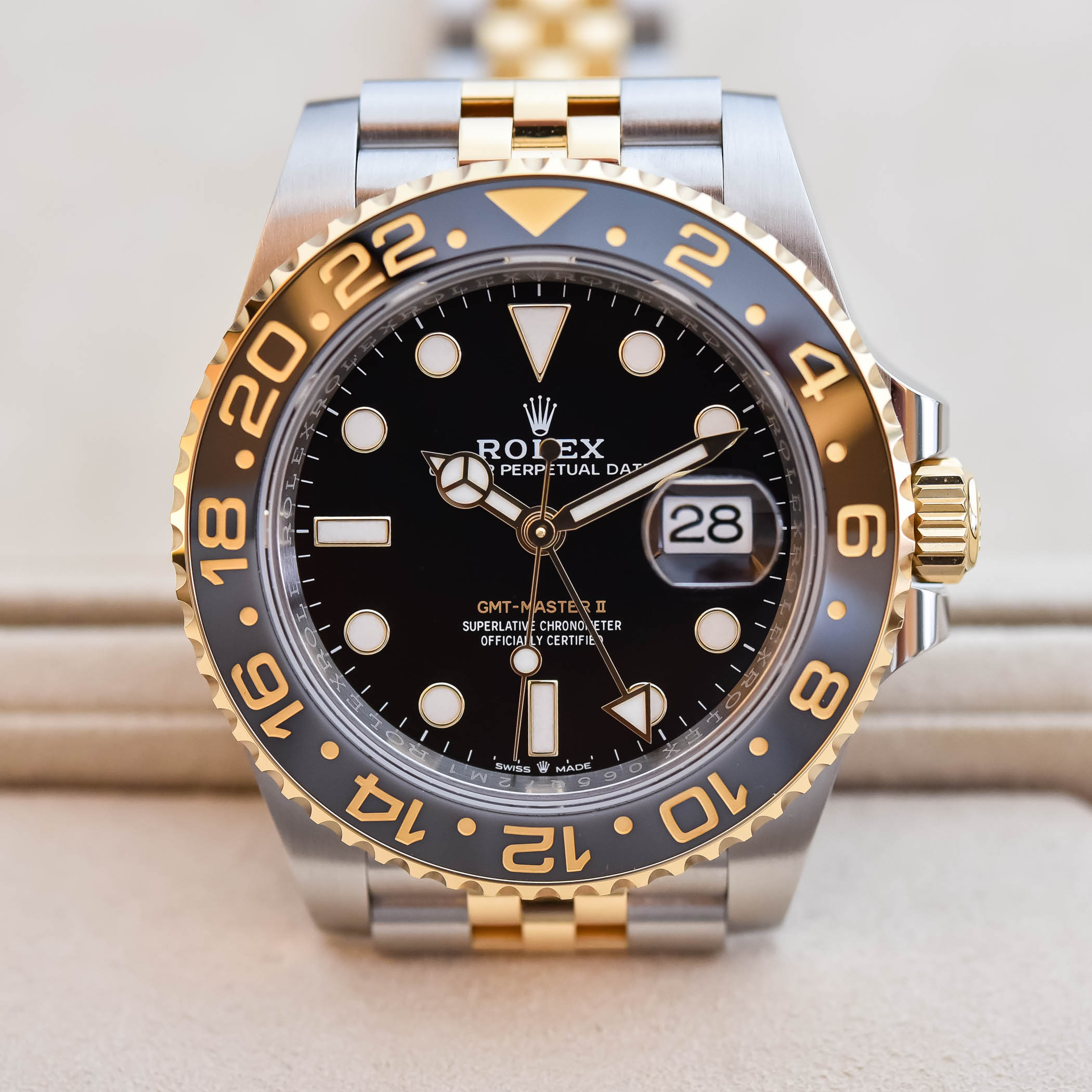
Mechanically, no evolution either here. The new Rolesor GMT-Master II comes equipped with the Calibre 3285, an in-house automatic movement with Superlative Chronometer certification – meaning COSC certification and internal Rolex testing after casing, with -2/+2 seconds/day accuracy range. It features all of the brand’s latest innovations, including the Chronergy escapement, the Parachrom hairspring and paramagnetic nickel-phosphorus pallet fork and escape wheel, with a comfortable 70h power reserve. And like all watches from the range, it’s a flyer/traveller’s GMT watch , with an independently adjustable local hour hand, by one-hour increments.
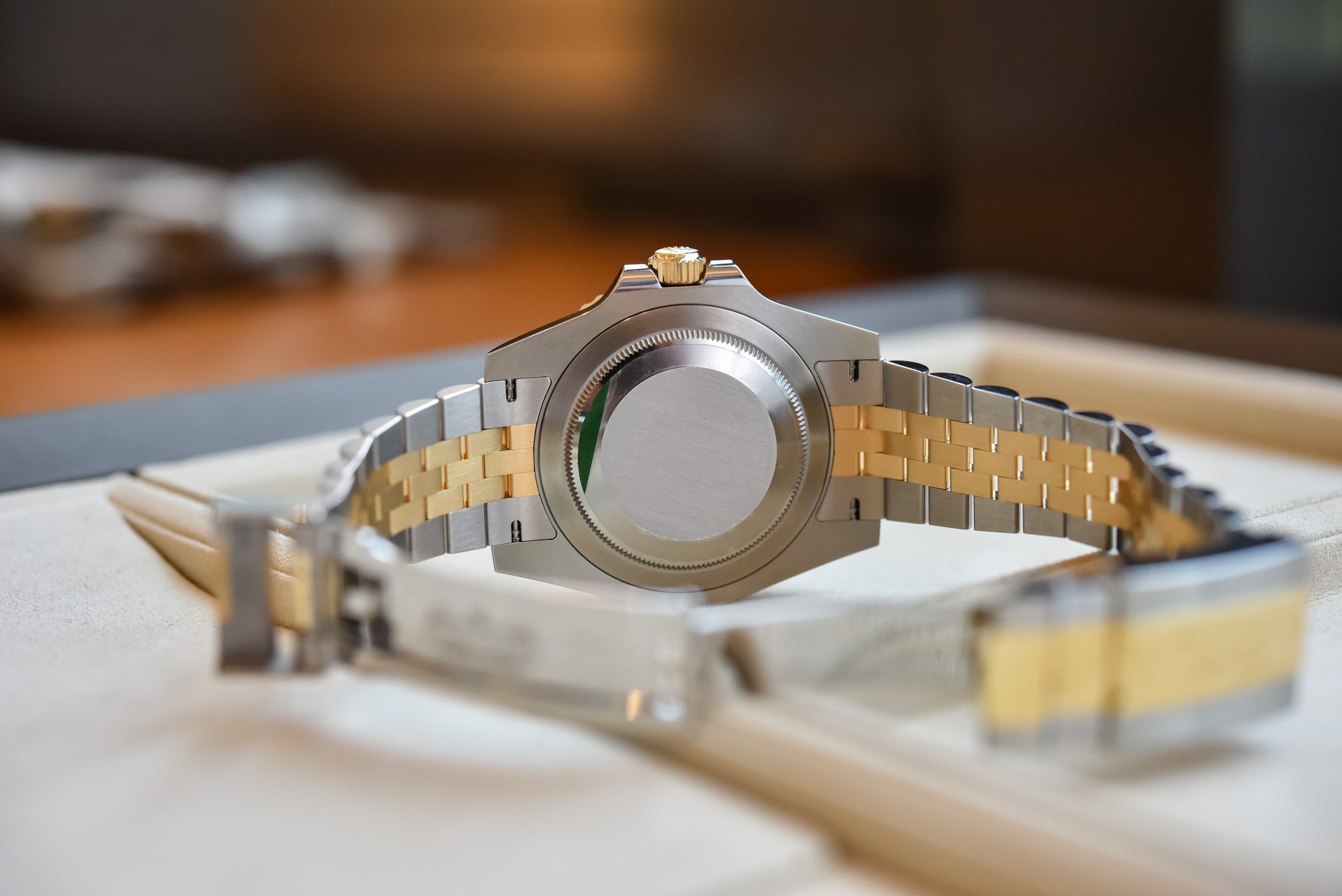
So, why did I fall for this new 126713GRNR…? Besides the obvious quality of the watch, there’s something that goes down, as simple as it is, to feelings. For a rather inexplicable, or at least tangible reason, this new model created emotions in me. I used to own a GMT-Master II in the past (a reference 116710LN to be precise) and I’ve always loved the functionality and overall robustness of the watch, but blamed a certain lack of warmth and fun. It felt too technical, too cold. While I do believe that most professional Rolex watches should be steel, due to their own purposeful nature, the GMT-Master II is the one watch in the range that can use some bling, some colours, and some precious materials… Keep in mind that the Rolex GMT has never been a pilot’s watch in the military sense of the concept. It has always been a civilian watch, for travelling up in the sky.

All in all, and I’m fully aware that I’m being subjective here, I do believe this 126713GRNR is the new coolest GMT. And yes, you can tell me that I’m wrong in the comments below and list what version you prefer, because in the end, it’s all about personal tastes.
The Rolex GMT-Master II Steel and Yellow Gold 126713GRNR is now released and “available” from retailers (relatively speaking, even if the situation seems to have recently improved a bit) at a price of EUR 16,300 , CHF 15,700 or USD 16,450 . More details at rolex.com .
Technical specifications – Rolex GMT-Master II Steel and Yellow Gold 126713GRNR
Leave a reply cancel reply, top stories.
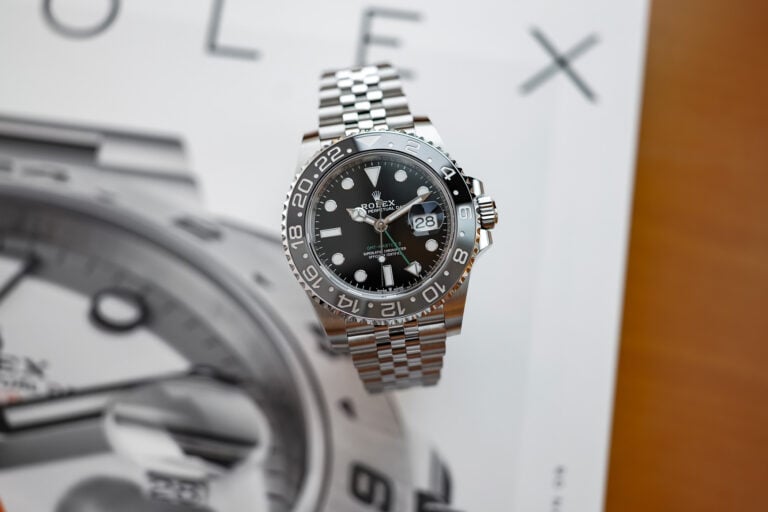
Opinion The Rolex GMT-Master II Bruce Wayne isn’t Boring, It’s Actually a…
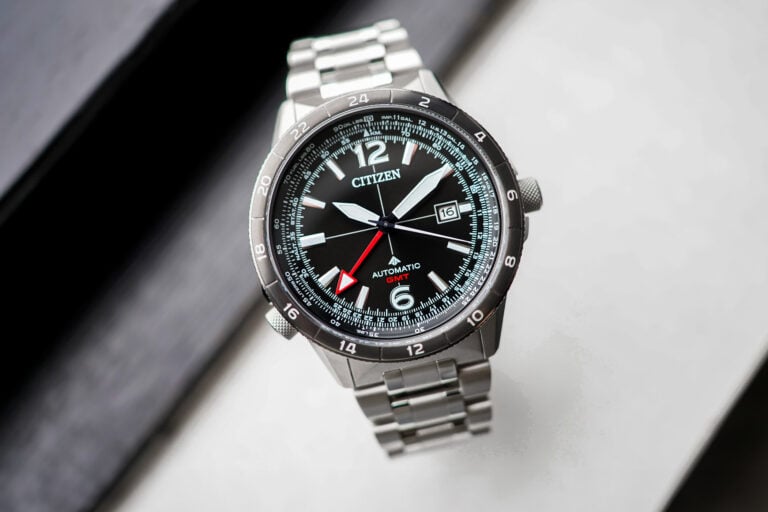
Hands-on The Citizen Promaster Sky Mechanical GMT – A Powerful, Accessible True…
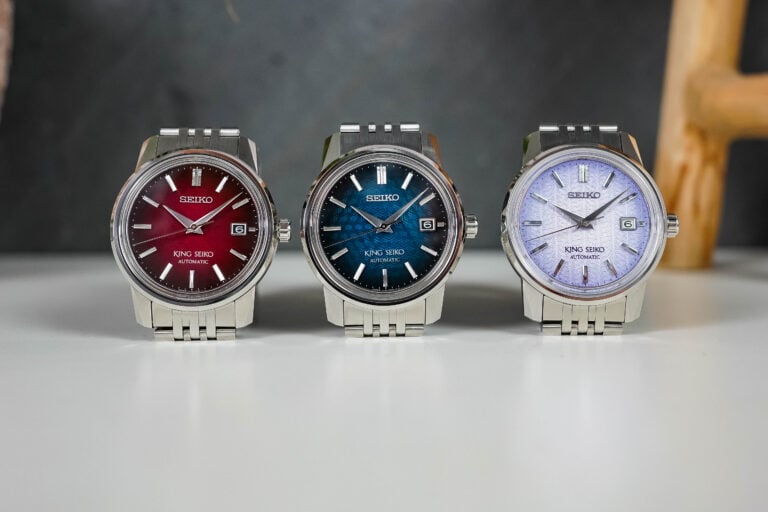
First Look Three New High-End King Seiko Watches with Colourful Textured Dials
Subscribe to our newsletter, subscribe to our newsletter.
Shop New Arrivals

Rolex Yacht-Master 168622 35MM Stainless Steel, Oyster Band Platinum Dial & Bezel, B&P (2016) $ 8,595

Rolex Yacht-Master 226659 42MM Falcon's Eye Chromalight Dial White Gold on Oysterflex, B&P (2022) $ 52,995

Rolex Yacht-Master 16623 40MM Steel & 18k Gold, Timing Bezel Slate Dial, Rolex Papers (2005) $ 11,795

Rolex Yacht-Master 126622 40MM Stainless Steel, Platinum Bezel Blue Chromalight Dial, B&P (2022) $ 14,595
- Yacht-Master
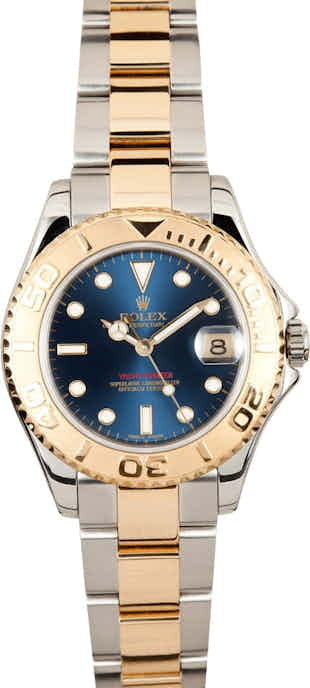
Rolex Yachtmaster Two Tone 168623
Join the product waitlist & get first dibs.
Are you an adventurer looking for a watch to match your spirit? Meet the Rolex Yachtmaster, a timeless classic specifically developed for those who seek to journey throughout the world in search of endless adventure. The Rolex Yachtmaster is a versatile watch that can be enjoyed both on the sea and on land as you seek to succeed in the boardroom, enjoy the most elegant of parties, and even conquer the toughest of golf courses. With its rugged waterproof case, self-winding technology, rotating bezel, and handsome design, the Rolex Yacht-master can be worn in nearly any setting and was made to last the test of time. Depending on your choice in colors and style, there are a number of Yachtmaster Rolex watches from which to choose. The Rolex Yachtmaster price can vary per the year released to market, bracelet type, and degree of rarity. Learn more about the Rolex Yachtmaster by Googling Yachtmaster Rolex price or Google Rolex Yachtmaster Review .
It was a seem less transaction. I was apprehensive at first because I have never acquired a watch of this caliber online. The watch arrived the next day as advertised. I would do business with Bob’s again and recommend it.
Beautiful watch in great condition.
Bought my 3rd watch from Bob. Will be back for more.
Your product review has been submitted for review.
The reviews what people are saying.
Great service and my watch arrived as described. Easy website to make my purchase. I would use Bob's Watches again.
3rd Purchase. Once again, it was fast and friendly. 100% positive. Thank you! Jason S. Chicago Incredibly easy to work with, and Larry went above and beyond and making an easy transaction. Would highly recommend!
Overall great experience and Bob’s Watches made it a seamless, simple process. I sold a Rolex and worked with Max who was excellent to work with. Would consider Bob’s Watches again for sale or purchase of Rolex.
Do you have questions about our Steel and Gold Rolex 168623 for sale? Our team of friendly watch experts is here to assist you. Whether you're curious about its features, authenticity, or purchasing process, we're just a call or email away. Don't hesitate to reach out; your perfect Blue Rolex Yacht-Master watch is just a conversation away.
Choosing Bob's Watches for your luxury watch purchase ensures unparalleled authenticity and quality. Our stringent authentication process, performed by a team of experts, guarantees that every watch is genuine and original. We offer certified pre-owned watches that meet our high standards for condition and functionality, giving you peace of mind with your Rolex investment. Additionally, our in-house professional servicing ensures that each timepiece is meticulously maintained and performs at its best. Finally, our comprehensive warranty provides long-term support, covering parts and labor.
Rolex watches are synonymous with luxury, style, and precision. These iconic timepieces are crafted using only the highest quality materials, including precious metals and gemstones. Rolex watches are designed to withstand the test of time, with intricate movements and advanced technology ensuring unparalleled accuracy and reliability. As a status symbol of success and sophistication, Rolex watches continue to be highly sought after by collectors and enthusiasts worldwide. Learn more by reading our Rolex watches ultimate guide and discover the finest collection of Rolex for sale, embodying luxury and precision.
We are proud to present a collection of authentic, unworn or pre-owned luxury watches that have been rigorously verified for authenticity. Each timepiece is subject to an extensive authentication procedure, ensuring that every purchase is made with assurance and worn with prestige. We guarantee a shopping experience free from counterfeits.
- Places - European, Western and Northern Russia
YEKATERINBURG: FACTORIES, URAL SIGHTS, YELTSIN AND THE WHERE NICHOLAS II WAS KILLED
Sverdlovsk oblast.
Sverdlovsk Oblast is the largest region in the Urals; it lies in the foothills of mountains and contains a monument indicating the border between Europe and Asia. The region covers 194,800 square kilometers (75,200 square miles), is home to about 4.3 million people and has a population density of 22 people per square kilometer. About 83 percent of the population live in urban areas. Yekaterinburg is the capital and largest city, with 1.5 million people. For Russians, the Ural Mountains are closely associated with Pavel Bazhov's tales and known for folk crafts such as Kasli iron sculpture, Tagil painting, and copper embossing. Yekaterinburg is the birthplace of Russia’s iron and steel industry, taking advantage of the large iron deposits in the Ural mountains. The popular Silver Ring of the Urals tourist route starts here.
In the summer you can follow in the tracks of Yermak, climb relatively low Ural mountain peaks and look for boulders seemingly with human faces on them. You can head to the Gemstone Belt of the Ural mountains, which used to house emerald, amethyst and topaz mines. In the winter you can go ice fishing, ski and cross-country ski.
Sverdlovsk Oblast and Yekaterinburg are located near the center of Russia, at the crossroads between Europe and Asia and also the southern and northern parts of Russia. Winters are longer and colder than in western section of European Russia. Snowfalls can be heavy. Winter temperatures occasionally drop as low as - 40 degrees C (-40 degrees F) and the first snow usually falls in October. A heavy winter coat, long underwear and good boots are essential. Snow and ice make the sidewalks very slippery, so footwear with a good grip is important. Since the climate is very dry during the winter months, skin moisturizer plus lip balm are recommended. Be alert for mud on street surfaces when snow cover is melting (April-May). Patches of mud create slippery road conditions.
Yekaterinburg
Yekaterinburg (kilometer 1818 on the Trans-Siberian Railway) is the fourth largest city in Russia, with of 1.5 million and growth rate of about 12 percent, high for Russia. Located in the southern Ural mountains, it was founded by Peter the Great and named after his wife Catherine, it was used by the tsars as a summer retreat and is where tsar Nicholas II and his family were executed and President Boris Yeltsin lived most of his life and began his political career. The city is near the border between Europe and Asia.
Yekaterinburg (also spelled Ekaterinburg) is located on the eastern slope of the Ural Mountains in the headwaters of the Iset and Pyshma Rivers. The Iset runs through the city center. Three ponds — Verkh-Isetsky, Gorodskoy and Nizhne-Isetsky — were created on it. Yekaterinburg has traditionally been a city of mining and was once the center of the mining industry of the Urals and Siberia. Yekaterinburg remains a major center of the Russian armaments industry and is sometimes called the "Pittsburgh of Russia.". A few ornate, pastel mansions and wide boulevards are reminders of the tsarist era. The city is large enough that it has its own Metro system but is characterized mostly by blocky Soviet-era apartment buildings. The city has advanced under President Vladimir Putin and is now one of the fastest growing places in Russia, a country otherwise characterized by population declines
Yekaterinburg is technically an Asian city as it lies 32 kilometers east of the continental divide between Europe and Asia. The unofficial capital of the Urals, a key region in the Russian heartland, it is second only to Moscow in terms of industrial production and capital of Sverdlovsk oblast. Among the important industries are ferrous and non-ferrous metallurgy, machine building and metalworking, chemical and petrochemicals, construction materials and medical, light and food industries. On top of being home of numerous heavy industries and mining concerns, Yekaterinburg is also a major center for industrial research and development and power engineering as well as home to numerous institutes of higher education, technical training, and scientific research. In addition, Yekaterinburg is the largest railway junction in Russia: the Trans-Siberian Railway passes through it, the southern, northern, western and eastern routes merge in the city.
Accommodation: There are two good and affordable hotels — the 3-star Emerald and Parus hotels — located close to the city's most popular landmarks and main transport interchanges in the center of Yekaterinburg. Room prices start at RUB 1,800 per night.
History of Yekaterinburg
Yekaterinburg was founded in 1723 by Peter the Great and named after his wife Catherine I. It was used by the tsars as a summer retreat but was mainly developed as metalworking and manufacturing center to take advantage of the large deposits of iron and other minerals in the Ural mountains. It is best known to Americans as the place where the last Tsar and his family were murdered by the Bolsheviks in 1918 and near where American U-2 spy plane, piloted by Gary Powers, was shot down in 1960.
Peter the Great recognized the importance of the iron and copper-rich Urals region for Imperial Russia's industrial and military development. In November 1723, he ordered the construction of a fortress factory and an ironworks in the Iset River Valley, which required a dam for its operation. In its early years Yekaterinburg grew rich from gold and other minerals and later coal. The Yekaterinburg gold rush of 1745 created such a huge amount of wealth that one rich baron of that time hosted a wedding party that lasted a year. By the mid-18th century, metallurgical plants had sprung up across the Urals to cast cannons, swords, guns and other weapons to arm Russia’s expansionist ambitions. The Yekaterinburg mint produced most of Russia's coins. Explorations of the Trans-Baikal and Altai regions began here in the 18th century.
Iron, cast iron and copper were the main products. Even though Iron from the region went into the Eiffel Tower, the main plant in Yekaterinburg itself was shut down in 1808. The city still kept going through a mountain factory control system of the Urals. The first railway in the Urals was built here: in 1878, the Yekaterinburg-Perm railway branch connected the province's capital with the factories of the Middle Urals.
In the Soviet era the city was called Sverdlovsk (named after Yakov Sverdlov, the man who organized Nicholas II's execution). During the first five-year plans the city became industrial — old plants were reconstructed, new ones were built. The center of Yekaterinburg was formed to conform to the historical general plan of 1829 but was the layout was adjusted around plants and factories. In the Stalin era the city was a major gulag transhipment center. In World War II, many defense-related industries were moved here. It and the surrounding area were a center of the Soviet Union's military industrial complex. Soviet tanks, missiles and aircraft engines were made in the Urals. During the Cold War era, Yekaterinburg was a center of weapons-grade uranium enrichment and processing, warhead assembly and dismantlement. In 1979, 64 people died when anthrax leaked from a biological weapons facility. Yekaterinburg was a “Closed City” for 40 years during the Cold Soviet era and was not open to foreigners until 1991
In the early post-Soviet era, much like Pittsburgh in the 1970s, Yekaterinburg had a hard struggle d to cope with dramatic economic changes that have made its heavy industries uncompetitive on the world market. Huge defense plants struggled to survive and the city was notorious as an organized crime center in the 1990s, when its hometown boy Boris Yeltsin was President of Russia. By the 2000s, Yekaterinburg’s retail and service was taking off, the defense industry was reviving and it was attracting tech industries and investments related to the Urals’ natural resources. By the 2010s it was vying to host a world exhibition in 2020 (it lost, Dubai won) and it had McDonald’s, Subway, sushi restaurants, and Gucci, Chanel and Armani. There were Bentley and Ferrari dealerships but they closed down
Transportation in Yekaterinburg
Getting There: By Plane: Yekaterinburg is a three-hour flight from Moscow with prices starting at RUB 8,000, or a 3-hour flight from Saint Petersburg starting from RUB 9,422 (direct round-trip flight tickets for one adult passenger). There are also flights from Frankfurt, Istanbul, China and major cities in the former Soviet Union.
By Train: Yekaterinburg is a major stop on the Trans-Siberian Railway. Daily train service is available to Moscow and many other Russian cities.Yekaterinburg is a 32-hour train ride from Moscow (tickets RUB 8,380 and above) or a 36-hour train ride from Saint Petersburg (RUB 10,300 and above). The ticket prices are round trip for a berth in a sleeper compartment for one adult passenger). By Car: a car trip from Moscow to Yekateringburg is 1,787 kilometers long and takes about 18 hours. The road from Saint Petersburg is 2,294 kilometers and takes about 28 hours.
Regional Transport: The region's public transport includes buses and suburban electric trains. Regional trains provide transport to larger cities in the Ural region. Buses depart from Yekaterinburg’s two bus stations: the Southern Bus Station and the Northern Bus Station.
Regional Transport: According the to Association for Safe International Road Travel (ASIRT): “Public transportation is well developed. Overcrowding is common. Fares are low. Service is efficient. Buses are the main form of public transport. Tram network is extensive. Fares are reasonable; service is regular. Trams are heavily used by residents, overcrowding is common. Purchase ticket after boarding. Metro runs from city center to Uralmash, an industrial area south of the city. Metro ends near the main railway station. Fares are inexpensive.
“Traffic is congested in city center. Getting around by car can be difficult. Route taxis (minivans) provide the fastest transport. They generally run on specific routes, but do not have specific stops. Drivers stop where passengers request. Route taxis can be hailed. Travel by bus or trolleybuses may be slow in rush hour. Trams are less affected by traffic jams. Trolley buses (electric buses) cannot run when temperatures drop below freezing.”
Entertainment, Sports and Recreation in Yekaterinburg
The performing arts in Yekaterinburg are first rate. The city has an excellent symphony orchestra, opera and ballet theater, and many other performing arts venues. Tickets are inexpensive. The Yekaterinburg Opera and Ballet Theater is lavishly designed and richly decorated building in the city center of Yekaterinburg. The theater was established in 1912 and building was designed by architect Vladimir Semyonov and inspired by the Vienna Opera House and the Theater of Opera and Ballet in Odessa.
Vaynera Street is a pedestrian only shopping street in city center with restaurants, cafes and some bars. But otherwise Yekaterinburg's nightlife options are limited. There are a handful of expensive Western-style restaurants and bars, none of them that great. Nightclubs serve the city's nouveau riche clientele. Its casinos have closed down. Some of them had links with organized crime. New dance clubs have sprung up that are popular with Yekaterinburg's more affluent youth.
Yekaterinburg's most popular spectator sports are hockey, basketball, and soccer. There are stadiums and arenas that host all three that have fairly cheap tickets. There is an indoor water park and lots of parks and green spaces. The Urals have many lakes, forests and mountains are great for hiking, boating, berry and mushroom hunting, swimming and fishing. Winter sports include cross-country skiing and ice skating. Winter lasts about six months and there’s usually plenty of snow. The nearby Ural Mountains however are not very high and the downhill skiing opportunities are limited..
Sights in Yekaterinburg
Sights in Yekaterinburg include the Museum of City Architecture and Ural Industry, with an old water tower and mineral collection with emeralds. malachite, tourmaline, jasper and other precious stone; Geological Alley, a small park with labeled samples of minerals found in the Urals region; the Ural Geology Museum, which houses an extensive collection of stones, gold and gems from the Urals; a monument marking the border between Europe and Asia; a memorial for gulag victims; and a graveyard with outlandish memorials for slain mafia members.
The Military History Museum houses the remains of the U-2 spy plane shot down in 1960 and locally made tanks and rocket launchers. The fine arts museum contains paintings by some of Russia's 19th-century masters. Also worth a look are the History an Local Studies Museum; the Political History and Youth Museum; and the University and Arboretum. Old wooden houses can be seen around Zatoutstovsya ulitsa and ulitsa Belinskogo. Around the city are wooded parks, lakes and quarries used to harvest a variety of minerals. Weiner Street is the main street of Yekaterinburg. Along it are lovely sculptures and 19th century architecture. Take a walk around the unique Literary Quarter
Plotinka is a local meeting spot, where you will often find street musicians performing. Plotinka can be described as the center of the city's center. This is where Yekaterinburg holds its biggest events: festivals, seasonal fairs, regional holiday celebrations, carnivals and musical fountain shows. There are many museums and open-air exhibitions on Plotinka. Plotinka is named after an actual dam of the city pond located nearby (“plotinka” means “a small dam” in Russian).In November 1723, Peter the Great ordered the construction of an ironworks in the Iset River Valley, which required a dam for its operation. “Iset” can be translated from Finnish as “abundant with fish”. This name was given to the river by the Mansi — the Finno-Ugric people dwelling on the eastern slope of the Northern Urals.
Vysotsky and Iset are skyscrapers that are 188.3 meters and 209 meters high, respectively. Fifty-story-high Iset has been described by locals as the world’s northernmost skyscraper. Before the construction of Iset, Vysotsky was the tallest building of Yekaterinburg and Russia (excluding Moscow). A popular vote has decided to name the skyscraper after the famous Soviet songwriter, singer and actor Vladimir Vysotsky. and the building was opened on November 25, 2011. There is a lookout at the top of the building, and the Vysotsky museum on its second floor. The annual “Vysotsky climb” (1137 steps) is held there, with a prize of RUB 100,000. While Vysotsky serves as an office building, Iset, owned by the Ural Mining and Metallurgical Company, houses 225 premium residential apartments ranging from 80 to 490 square meters in size.
Boris Yeltsin Presidential Center
The Boris Yeltsin Presidential Center (in the city center: ul. Yeltsina, 3) is a non-governmental organization named after the first president of the Russian Federation. The Museum of the First President of Russia as well as his archives are located in the Center. There is also a library, educational and children's centers, and exposition halls. Yeltsin lived most of his life and began his political career in Yekaterinburg. He was born in Butka about 200 kilometers east of Yekaterinburg.
The core of the Center is the Museum. Modern multimedia technologies help animate the documents, photos from the archives, and artifacts. The Yeltsin Museum holds collections of: propaganda posters, leaflets, and photos of the first years of the Soviet regime; portraits and portrait sculptures of members of Politburo of the Central Committee of the Communist Party of various years; U.S.S.R. government bonds and other items of the Soviet era; a copy of “One Day in the Life of Ivan Denisovich” by Alexander Solzhenitsyn, published in the “Novy Mir” magazine (#11, 1962); perestroika-era editions of books by Alexander Solzhenitsyn, Vasily Grossman, and other authors; theater, concert, and cinema posters, programs, and tickets — in short, all of the artifacts of the perestroika era.
The Yeltsin Center opened in 2012. Inside you will also find an art gallery, a bookstore, a gift shop, a food court, concert stages and a theater. There are regular screenings of unique films that you will not find anywhere else. Also operating inside the center, is a scientific exploritorium for children. The center was designed by Boris Bernaskoni. Almost from the its very opening, the Yeltsin Center has been accused by members of different political entities of various ideological crimes. The museum is open Tuesday to Sunday, from 10:00am to 9:00pm.
Where Nicholas II was Executed
On July, 17, 1918, during this reign of terror of the Russian Civil War, former-tsar Nicholas II, his wife, five children (the 13-year-old Alexis, 22-year-old Olga, 19-year-old Maria and 17-year-old Anastasia)the family physician, the cook, maid, and valet were shot to death by a Red Army firing squad in the cellar of the house they were staying at in Yekaterinburg.
Ipatiev House (near Church on the Blood, Ulitsa Libknekhta) was a merchant's house where Nicholas II and his family were executed. The house was demolished in 1977, on the orders of an up and coming communist politician named Boris Yeltsin. Yeltsin later said that the destruction of the house was an "act of barbarism" and he had no choice because he had been ordered to do it by the Politburo,
The site is marked with s cross with the photos of the family members and cross bearing their names. A small wooden church was built at the site. It contains paintings of the family. For a while there were seven traditional wooden churches. Mass is given ay noon everyday in an open-air museum. The Church on the Blood — constructed to honor Nicholas II and his family — was built on the part of the site in 1991 and is now a major place of pilgrimage.
Nicholas and his family where killed during the Russian civil war. It is thought the Bolsheviks figured that Nicholas and his family gave the Whites figureheads to rally around and they were better of dead. Even though the death orders were signed Yakov Sverdlov, the assassination was personally ordered by Lenin, who wanted to get them out of sight and out of mind. Trotsky suggested a trial. Lenin nixed the idea, deciding something had to be done about the Romanovs before White troops approached Yekaterinburg. Trotsky later wrote: "The decision was not only expedient but necessary. The severity of he punishment showed everyone that we would continue to fight on mercilessly, stopping at nothing."
Ian Frazier wrote in The New Yorker: “Having read a lot about the end of Tsar Nicholas II and his family and servants, I wanted to see the place in Yekaterinburg where that event occurred. The gloomy quality of this quest depressed Sergei’s spirits, but he drove all over Yekaterinburg searching for the site nonetheless. Whenever he stopped and asked a pedestrian how to get to the house where Nicholas II was murdered, the reaction was a wince. Several people simply walked away. But eventually, after a lot of asking, Sergei found the location. It was on a low ridge near the edge of town, above railroad tracks and the Iset River. The house, known as the Ipatiev House, was no longer standing, and the basement where the actual killings happened had been filled in. I found the blankness of the place sinister and dizzying. It reminded me of an erasure done so determinedly that it had worn a hole through the page. [Source: Ian Frazier, The New Yorker, August 3, 2009, Frazier is author of “Travels in Siberia” (2010)]
“The street next to the site is called Karl Liebknecht Street. A building near where the house used to be had a large green advertisement that said, in English, “LG—Digitally Yours.” On an adjoining lot, a small chapel kept the memory of the Tsar and his family; beneath a pedestal holding an Orthodox cross, peonies and pansies grew. The inscription on the pedestal read, “We go down on our knees, Russia, at the foot of the tsarist cross.”
Books: The Romanovs: The Final Chapter by Robert K. Massie (Random House, 1995); The Fall of the Romanovs by Mark D. Steinberg and Vladimir Khrustalëv (Yale, 1995);
See Separate Article END OF NICHOLAS II factsanddetails.com
Execution of Nicholas II
According to Robert Massie K. Massie, author of Nicholas and Alexandra, Nicholas II and his family were awakened from their bedrooms around midnight and taken to the basement. They were told they were to going to take some photographs of them and were told to stand behind a row of chairs.
Suddenly, a group of 11 Russians and Latvians, each with a revolver, burst into the room with orders to kill a specific person. Yakob Yurovsky, a member of the Soviet executive committee, reportedly shouted "your relatives are continuing to attack the Soviet Union.” After firing, bullets bouncing off gemstones hidden in the corsets of Alexandra and her daughters ricocheted around the room like "a shower of hail," the soldiers said. Those that were still breathing were killed with point black shots to the head.
The three sisters and the maid survived the first round thanks to their gems. They were pressed up against a wall and killed with a second round of bullets. The maid was the only one that survived. She was pursued by the executioners who stabbed her more than 30 times with their bayonets. The still writhing body of Alexis was made still by a kick to the head and two bullets in the ear delivered by Yurovsky himself.
Yurovsky wrote: "When the party entered I told the Romanovs that in view of the fact their relatives continued their offensive against Soviet Russia, the Executive Committee of the Urals Soviet had decided to shoot them. Nicholas turned his back to the detachment and faced his family. Then, as if collecting himself, he turned around, asking, 'What? What?'"
"[I] ordered the detachment to prepare. Its members had been previously instructed whom to shoot and to am directly at the heart to avoid much blood and to end more quickly. Nicholas said no more. he turned again to his family. The others shouted some incoherent exclamations. All this lasted a few seconds. Then commenced the shooting, which went on for two or three minutes. [I] killed Nicholas on the spot."
Nicholas II’s Initial Burial Site in Yekaterinburg
Ganina Yama Monastery (near the village of Koptyaki, 15 kilometers northwest of Yekaterinburg) stands near the three-meter-deep pit where some the remains of Nicholas II and his family were initially buried. The second burial site — where most of the remains were — is in a field known as Porosyonkov (56.9113628°N 60.4954326°E), seven kilometers from Ganina Yama.
On visiting Ganina Yama Monastery, one person posted in Trip Advisor: “We visited this set of churches in a pretty park with Konstantin from Ekaterinburg Guide Centre. He really brought it to life with his extensive knowledge of the history of the events surrounding their terrible end. The story is so moving so unless you speak Russian, it is best to come here with a guide or else you will have no idea of what is what.”
In 1991, the acid-burned remains of Nicholas II and his family were exhumed from a shallow roadside mass grave in a swampy area 12 miles northwest of Yekaterinburg. The remains had been found in 1979 by geologist and amateur archeologist Alexander Avdonin, who kept the location secret out of fear that they would be destroyed by Soviet authorities. The location was disclosed to a magazine by one his fellow discovers.
The original plan was to throw the Romanovs down a mine shaft and disposes of their remains with acid. They were thrown in a mine with some grenades but the mine didn't collapse. They were then carried by horse cart. The vats of acid fell off and broke. When the carriage carrying the bodies broke down it was decided the bury the bodies then and there. The remaining acid was poured on the bones, but most of it was soaked up the ground and the bones largely survived.
After this their pulses were then checked, their faces were crushed to make them unrecognizable and the bodies were wrapped in bed sheets loaded onto a truck. The "whole procedure," Yurovsky said took 20 minutes. One soldiers later bragged than he could "die in peace because he had squeezed the Empress's -------."
The bodies were taken to a forest and stripped, burned with acid and gasoline, and thrown into abandoned mine shafts and buried under railroad ties near a country road near the village of Koptyaki. "The bodies were put in the hole," Yurovsky wrote, "and the faces and all the bodies, generally doused with sulfuric acid, both so they couldn't be recognized and prevent a stink from them rotting...We scattered it with branches and lime, put boards on top and drove over it several times—no traces of the hole remained.
Shortly afterwards, the government in Moscow announced that Nicholas II had been shot because of "a counterrevolutionary conspiracy." There was no immediate word on the other members of the family which gave rise to rumors that other members of the family had escaped. Yekaterinburg was renamed Sverdlov in honor of the man who signed the death orders.
For seven years the remains of Nicholas II, Alexandra, three of their daughters and four servants were stored in polyethylene bags on shelves in the old criminal morgue in Yekaterunburg. On July 17, 1998, Nicholas II and his family and servants who were murdered with him were buried Peter and Paul Fortress in St. Petersburg along with the other Romanov tsars, who have been buried there starting with Peter the Great. Nicholas II had a side chapel built for himself at the fortress in 1913 but was buried in a new crypt.
Near Yekaterinburg
Factory-Museum of Iron and Steel Metallurgy (in Niznhy Tagil 80 kilometers north of Yekaterinburg) a museum with old mining equipment made at the site of huge abandoned iron and steel factory. Officially known as the Factory-Museum of the History of the Development of Iron and Steel Metallurgy, it covers an area of 30 hectares and contains a factory founded by the Demidov family in 1725 that specialized mainly in the production of high-quality cast iron and steel. Later, the foundry was renamed after Valerian Kuybyshev, a prominent figure of the Communist Party.
The first Russian factory museum, the unusual museum demonstrates all stages of metallurgy and metal working. There is even a blast furnace and an open-hearth furnace. The display of factory equipment includes bridge crane from 1892) and rolling stock equipment from the 19th-20th centuries. In Niznhy Tagil contains some huge blocks of malachite and
Nizhnyaya Sinyachikha (180 kilometers east-northeast of Yekaterinburg) has an open air architecture museum with log buildings, a stone church and other pre-revolutionary architecture. The village is the creation of Ivan Samoilov, a local activist who loved his village so much he dedicated 40 years of his life to recreating it as the open-air museum of wooden architecture.
The stone Savior Church, a good example of Siberian baroque architecture. The interior and exterior of the church are exhibition spaces of design. The houses are very colorful. In tsarist times, rich villagers hired serfs to paint the walls of their wooden izbas (houses) bright colors. Old neglected buildings from the 17th to 19th centuries have been brought to Nizhnyaya Sinyachikha from all over the Urals. You will see the interior design of the houses and hear stories about traditions and customs of the Ural farmers.
Verkhoturye (330 kilometers road from Yekaterinburg) is the home a 400-year-old monastery that served as 16th century capital of the Urals. Verkhoturye is a small town on the Tura River knows as the Jerusalem of the Urals for its many holy places, churches and monasteries. The town's main landmark is its Kremlin — the smallest in Russia. Pilgrims visit the St. Nicholas Monastery to see the remains of St. Simeon of Verkhoturye, the patron saint of fishermen.
Ural Mountains
Ural Mountains are the traditional dividing line between Europe and Asia and have been a crossroads of Russian history. Stretching from Kazakhstan to the fringes of the Arctic Kara Sea, the Urals lie almost exactly along the 60 degree meridian of longitude and extend for about 2,000 kilometers (1,300 miles) from north to south and varies in width from about 50 kilometers (30 miles) in the north and 160 kilometers (100 miles) the south. At kilometers 1777 on the Trans-Siberian Railway there is white obelisk with "Europe" carved in Russian on one side and "Asia" carved on the other.
The eastern side of the Urals contains a lot of granite and igneous rock. The western side is primarily sandstone and limestones. A number of precious stones can be found in the southern part of the Urals, including emeralds. malachite, tourmaline, jasper and aquamarines. The highest peaks are in the north. Mount Narodnaya is the highest of all but is only 1884 meters (6,184 feet) high. The northern Urals are covered in thick forests and home to relatively few people.
Like the Appalachian Mountains in the eastern United States, the Urals are very old mountains — with rocks and sediments that are hundreds of millions years old — that were one much taller than they are now and have been steadily eroded down over millions of years by weather and other natural processes to their current size. According to Encyclopedia Britannica: “The rock composition helps shape the topography: the high ranges and low, broad-topped ridges consist of quartzites, schists, and gabbro, all weather-resistant. Buttes are frequent, and there are north–south troughs of limestone, nearly all containing river valleys. Karst topography is highly developed on the western slopes of the Urals, with many caves, basins, and underground streams. The eastern slopes, on the other hand, have fewer karst formations; instead, rocky outliers rise above the flattened surfaces. Broad foothills, reduced to peneplain, adjoin the Central and Southern Urals on the east.
“The Urals date from the structural upheavals of the Hercynian orogeny (about 250 million years ago). About 280 million years ago there arose a high mountainous region, which was eroded to a peneplain. Alpine folding resulted in new mountains, the most marked upheaval being that of the Nether-Polar Urals...The western slope of the Urals is composed of middle Paleozoic sedimentary rocks (sandstones and limestones) that are about 350 million years old. In many places it descends in terraces to the Cis-Ural depression (west of the Urals), to which much of the eroded matter was carried during the late Paleozoic (about 300 million years ago). Found there are widespread karst (a starkly eroded limestone region) and gypsum, with large caverns and subterranean streams. On the eastern slope, volcanic layers alternate with sedimentary strata, all dating from middle Paleozoic times.”
Southern Urals
The southern Urals are characterized by grassy slopes and fertile valleys. The middle Urals are a rolling platform that barely rises above 300 meters (1,000 feet). This region is rich in minerals and has been heavily industrialized. This is where you can find Yekaterinburg (formally Sverdlovsk), the largest city in the Urals.
Most of the Southern Urals are is covered with forests, with 50 percent of that pine-woods, 44 percent birch woods, and the rest are deciduous aspen and alder forests. In the north, typical taiga forests are the norm. There are patches of herbal-poaceous steppes, northem sphagnous marshes and bushy steppes, light birch forests and shady riparian forests, tall-grass mountainous meadows, lowland ling marshes and stony placers with lichen stains. In some places there are no large areas of homogeneous forests, rather they are forests with numerous glades and meadows of different size.
In the Ilmensky Mountains Reserve in the Southern Urals, scientists counted 927 vascular plants (50 relicts, 23 endemic species), about 140 moss species, 483 algae species and 566 mushroom species. Among the species included into the Red Book of Russia are feather grass, downy-leaved feather grass, Zalessky feather grass, moccasin flower, ladies'-slipper, neottianthe cucullata, Baltic orchis, fen orchis, helmeted orchis, dark-winged orchis, Gelma sandwart, Krasheninnikov sandwart, Clare astragalus.
The fauna of the vertebrate animals in the Reserve includes 19 fish, 5 amphibian and 5 reptile. Among the 48 mammal species are elks, roe deer, boars, foxes, wolves, lynxes, badgers, common weasels, least weasels, forest ferrets, Siberian striped weasel, common marten, American mink. Squirrels, beavers, muskrats, hares, dibblers, moles, hedgehogs, voles are quite common, as well as chiropterans: pond bat, water bat, Brandt's bat, whiskered bat, northern bat, long-eared bat, parti-coloured bat, Nathusius' pipistrelle. The 174 bird bird species include white-tailed eagles, honey hawks, boreal owls, gnome owls, hawk owls, tawny owls, common scoters, cuckoos, wookcocks, common grouses, wood grouses, hazel grouses, common partridges, shrikes, goldenmountain thrushes, black- throated loons and others.
Activities and Places in the Ural Mountains
The Urals possess beautiful natural scenery that can be accessed from Yekaterinburg with a rent-a-car, hired taxi and tour. Travel agencies arrange rafting, kayaking and hiking trips. Hikes are available in the taiga forest and the Urals. Trips often include walks through the taiga to small lakes and hikes into the mountains and excursions to collect mushrooms and berries and climb in underground caves. Mellow rafting is offered in a relatively calm six kilometer section of the River Serga. In the winter visitor can enjoy cross-mountains skiing, downhill skiing, ice fishing, dog sledding, snow-shoeing and winter hiking through the forest to a cave covered with ice crystals.
Lake Shartash (10 kilometers from Yekaterinburg) is where the first Ural gold was found, setting in motion the Yekaterinburg gold rush of 1745, which created so much wealth one rich baron of that time hosted a wedding party that lasted a year. The area around Shartash Lake is a favorite picnic and barbecue spot of the locals. Getting There: by bus route No. 50, 054 or 54, with a transfer to suburban commuter bus route No. 112, 120 or 121 (the whole trip takes about an hour), or by car (10 kilometers drive from the city center, 40 minutes).
Revun Rapids (90 kilometers road from Yekaterinburg near Beklenishcheva village) is a popular white water rafting places On the nearby cliffs you can see the remains of a mysterious petroglyph from the Paleolithic period. Along the steep banks, you may notice the dark entrance of Smolinskaya Cave. There are legends of a sorceress who lived in there. The rocks at the riverside are suited for competitive rock climbers and beginners. Climbing hooks and rings are hammered into rocks. The most fun rafting is generally in May and June.
Olenii Ruchii National Park (100 kilometers west of Yekaterinburg) is the most popular nature park in Sverdlovsk Oblast and popular weekend getaway for Yekaterinburg residents. Visitors are attracted by the beautiful forests, the crystal clear Serga River and picturesque rocks caves. There are some easy hiking routes: the six-kilometer Lesser Ring and the 15-kilometer Greater Ring. Another route extends for 18 km and passes by the Mitkinsky Mine, which operated in the 18th-19th centuries. It's a kind of an open-air museum — you can still view mining an enrichment equipment here. There is also a genuine beaver dam nearby.
Among the other attractions at Olenii Ruchii are Druzhba (Friendship) Cave, with passages that extend for about 500 meters; Dyrovaty Kamen (Holed Stone), created over time by water of Serga River eroding rock; and Utoplennik (Drowned Man), where you can see “The Angel of Sole Hope”., created by the Swedish artist Lehna Edwall, who has placed seven angels figures in different parts of the world to “embrace the planet, protecting it from fear, despair, and disasters.”
Image Sources: Wikimedia Commons
Text Sources: Federal Agency for Tourism of the Russian Federation (official Russia tourism website russiatourism.ru ), Russian government websites, UNESCO, Wikipedia, Lonely Planet guides, New York Times, Washington Post, Los Angeles Times, National Geographic, The New Yorker, Bloomberg, Reuters, Associated Press, AFP, Yomiuri Shimbun and various books and other publications.
Updated in September 2020
- Google+
Page Top
This site contains copyrighted material the use of which has not always been authorized by the copyright owner. Such material is made available in an effort to advance understanding of country or topic discussed in the article. This constitutes 'fair use' of any such copyrighted material as provided for in section 107 of the US Copyright Law. In accordance with Title 17 U.S.C. Section 107, the material on this site is distributed without profit. If you wish to use copyrighted material from this site for purposes of your own that go beyond 'fair use', you must obtain permission from the copyright owner. If you are the copyright owner and would like this content removed from factsanddetails.com, please contact me.

IMAGES
VIDEO
COMMENTS
Like NEW 2019 Yacht-Master II Yellow Gold White Dial Mercedez Hand 116688 COMPLETE SET $ 42,495 + $99 for shipping. US. Rolex Yacht-Master II. 116688 $ 34,950. Free shipping. US. ... Pre-owned Two Tone Rose Gold Yacht-Master II 44mm 116681 $ 21,250 + $49 for shipping. US. Rolex Yacht-Master II. 116680 White Dial 2020 $ 18,350 + $75 for shipping ...
AE. Rolex Yacht-Master II. 116688 44mm 2015 Gelbgold 750 Chronograph Automatik 18kt Yellow Gold White Dial Oyster-band Chronometer. $ 42,097. + $228 for shipping. DE. Rolex Yacht-Master II. ロレックス ヨットマスターⅡ 116688 YG.
Pre-owned Two Tone Rose Gold Yacht-Master II 44mm 116681 $ 21,500 + $49 for shipping. US. Promoted. Rolex Yacht-Master II. 116680 $ 20,500 + $250 for shipping. US. ... Like NEW 2019 Yacht-Master II Yellow Gold White Dial Mercedez Hand 116688 COMPLETE SET $ 42,495 + $99 for shipping. US. Rolex Yacht-Master II. 2013 | 116680 $ 16,304
Learn about the features, design, and history of the Rolex Yacht-Master II 116681, a two-tone stainless steel and Everose gold watch with a regatta chronograph. Find out how to buy, sell, or trade this niche and technical piece from the Swiss giant.
Learn everything you need to know about buying Rolex Yacht-Master and Yacht-Master II watches, from their history, features, and pricing. The Yacht-Master 42 is a luxury sports watch with a 42mm case size and a bi-directional bezel.
The Yacht-Master 42 is a chronometer with a bidirectional rotatable bezel for calculating and reading navigational time. It is available in various precious metals and materials, and has a sporty and elegant design that transcends its nautical origins.
The original models of the Yacht-Master II were the 18k yellow gold ref 116688 and the even more luxurious 18k white gold version with a platinum bezel, ref 116689. These models showcased a large, eye-catching design that was an immediate topic of debate among watch enthusiasts. ... tailored for yacht racing. The combination of two-tone metals ...
2019 MINT PAPERS Rolex Yacht-Master II 2 MERC HANDS Steel Blue 116680 Watch ... £ 14,250. Excl. shipping. UK. Private Seller. Rolex Yacht-Master II. 2 116681 Two tone 18k Everose Gold Mercedes 2018 44mm ... 116688 YACHTMASTER II 18K YELLOW GOLD NEWER DIAL 2022 WARRANTY FULL SET
Find your perfect Rolex Yacht Master II at Bob's Watches, a trusted online marketplace for pre-owned and new watches. Learn about the features, prices, and comparisons of this maritime-inspired collection with a programmable countdown and regatta chronograph.
Rolex 116688-0002 description. The Yacht-Master II is designed to meet the needs of professional sailors. This regatta chronograph features the world's first programmable countdown with a mechanical memory. It provides precise synchronization with the crucial starting sequence of a yacht race. The Yacht-Master II was first introduced in 2007 in ...
Rolex Yacht-Master watches also feature bracelets in exquisite Rolesor—a combination of Oystersteel and gleaming 18k yellow gold or Everose gold. Some models in the Yacht-Master collection also feature a stunning bezel and dial. Sporting Elegance. Many Rolex Yacht-Master watches sport a patented Oysterflex bracelet. This flexible black water ...
Find new and used Rolex Yacht-Master watches for sale on Chrono24.com, the global marketplace for luxury watches. Compare prices, models, materials, dials, and more of the Yacht-Master collection.
Yacht Master Innovations. One of the biggest expansions of the Rolex Yacht-Master collection came after the turn of the millennium, in the year 2005. It was in this year that the full-size model first became available in the two-tone Rolesor combination of yellow gold and stainless steel, with that particular model going by the name Reference ...
Two-tone Yacht-Master II 116681. If you're a fan of two-tone Rolex sports watches, then there's the stainless steel and gold Yacht-Master II ref. 116681. However, rather than using the more classic yellow gold, ... And the yellow gold Yacht-Master II ref. 116688 is no exception. Built almost entirely in 18k yellow gold-except for that ...
Learn everything about the Rolex Yacht-Master II, a luxury professional sailing watch with a programmable regatta timer. Find out how much it costs new and pre-owned, and how it evolved since its launch in 2007.
A hands-on review of the new Rolex GMT-Master II Steel and Yellow Gold 126713GRNR, featuring a black and mid-grey ceramic bezel and a Jubilee bracelet. Learn why this watch is attractive, subtle and elegant, despite being a two-tone model.
116681 Yacht-Master II Two Tone Rose Gold 44mm $ 28,325. Free shipping. US. Rolex Yacht-Master II. 44mm Mercedes Hands 116680 $ 16,550 + $95 for shipping. US. Rolex Yacht-Master II. Full Set Under Warranty kept in safe ... Unworn Yellow Gold Yacht-Master II 44mm 116688 $ 49,500 + $49 for shipping. US. Rolex Yacht-Master II.
Ekaterinburg. Ekaterinburg (also known as Yekaterinburg) is the third largest Russian city, administrative centre of the Sverdlovsk region and the capital of the Urals. Sverdlovsk oblast is one of the most developed and advanced regions in Russia. It is very rich in minerals and raw materials - the main industries are heavy machinery and metallurgy.
Gold 1905, Boutique Hotel is located in the city center in the building of the cultural heritage. In the immediate vicinity of the hotel is The square of 1905 and the metro station of the same name, the administration of Yekaterinburg and shopping centers-Passage, TSUM and Uspensky, and after a couple of blocks - you can walk along the embankment of the river Iset.
5. Chertovo Gorodische. 112. Points of Interest & Landmarks. By saronic. The about 100m long and 20m high rock wall is impressive. It is a phenomenon, which can be found also in other places... 6. Vaynera Street, Yekaterinburg.
Model Name/Number: Yacht-Master 168623 Serial/Year: Y 2002/2003 Gender: Midsize (35mm) Features: Automatic movement w/date, scratch-resistant sapphire crystal, waterproof screw-down crown Case: Stainless steel w/ 18k yellow gold rotatable time-lapse bezel Dial: Blue w/ gold trimmed luminous index hour markers Bracelet: Stainless steel and 18k yellow gold Oyster Box & Papers: Bob's presentation ...
Midsize 35mm White 2-tone Yellow Gold/Steel Watch 68623 $ 7,600. ... Two-Tone Yellow Gold Stainless RHODIUM Gray 35mm Watch 168623 $ 6,993 + $150 for shipping. US. Rolex Yacht-Master. 68623 Midsize Silver Dial Watch Box Papers $ 8,999 + $50 for shipping. US. Rolex Yacht-Master. MINT Condition Yacht-Master 35mm 2-Tone Factory Tahitian Mother of ...
The Yekaterinburg gold rush of 1745 created such a huge amount of wealth that one rich baron of that time hosted a wedding party that lasted a year. By the mid-18th century, metallurgical plants had sprung up across the Urals to cast cannons, swords, guns and other weapons to arm Russia's expansionist ambitions.